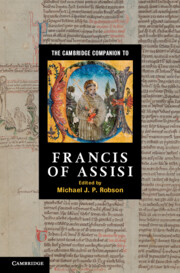Book contents
- Frontmatter
- Introduction
- PART I Francis of Assisi
- PART II The heritage of Francis of Assisi
- 10 Francis and the pursuit of learning
- 11 The early Franciscans and the towns and cities
- 12 The Third Order of Francis
- 13 Franciscan ideals and the royal family of France (1226–1328)
- 14 Franciscans as papal and royal envoys to the Tartars (1245–1255)
- 15 Franciscan missions
- 16 Pope John XXII, the Franciscan order and its Rule
- 17 The ecumenical appeal of Francis
- A guide to further reading
- Index
11 - The early Franciscans and the towns and cities
from PART II - The heritage of Francis of Assisi
Published online by Cambridge University Press: 28 November 2011
- Frontmatter
- Introduction
- PART I Francis of Assisi
- PART II The heritage of Francis of Assisi
- 10 Francis and the pursuit of learning
- 11 The early Franciscans and the towns and cities
- 12 The Third Order of Francis
- 13 Franciscan ideals and the royal family of France (1226–1328)
- 14 Franciscans as papal and royal envoys to the Tartars (1245–1255)
- 15 Franciscan missions
- 16 Pope John XXII, the Franciscan order and its Rule
- 17 The ecumenical appeal of Francis
- A guide to further reading
- Index
Summary
As the son of a successful merchant, Francesco Bernardone grew up in a city, enjoying his father's wealth and social status. He was formed by an urban style of life which included distinctive entertainments and festivities, and his training and education prepared him for a world of commerce which was centred on towns. He took on this role in his early 20s at the latest, when he was following in his father's footsteps, e.g., transporting bales of cloth from Assisi to nearby towns for sale there (1 Cel., 8). Thomas of Celano describes him in this phase of his life as an urban dweller who lacked any sense of the beauties of nature (1 Cel., 3). All this changed with his conversion, which included not only rejection of his social status and breaking with his family, but also abandonment of his urban lifestyle and indeed departure from the town of Assisi itself (1 Cel., 16). Later in the thirteenth century the symbolic value of abandoning urban life in favour of religion was underlined by Bonaventure of Bagnoregio, Paris master and minister general of the order, who, in a commentary on the Gospel of Luke, stated: ‘Travelling into the desert and abandoning the town means abandoning the secular and entering the life of religion.’
- Type
- Chapter
- Information
- The Cambridge Companion to Francis of Assisi , pp. 178 - 192Publisher: Cambridge University PressPrint publication year: 2011



